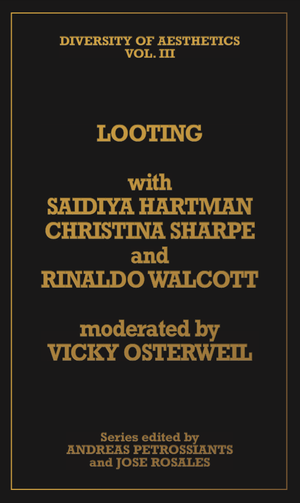Looting Roundtable Available Now

I am so happy and proud to announce you can purchase Diversity of Aesthetics Vol III, the roundtable discussion I did with Rinaldo Walcott, Christina Sharpe and Saidiya Hartman about Looting! You can buy it at Common Notions!
We’re so proud of how it turned out, and I think you’ll really enjoy it. I published the intro once before, but I’m republishing it here for folks who either missed it or want a quick refresher.
The following conversation with Christina Sharpe, Rinaldo Walcott, and Saidiya Hartman was held in fall of 2022, two years after the fires of the George Floyd Rebellion had faded. It took place in a period of long reactionary retrenchment and ennui, driven by exacerbation and denial of the coronavirus pandemic and fascist attacks on reproductive health and queer life. The forgetting of the uprising has been a crucial part of this reaction, and is an active and ongoing process.
It is in the interests of white supremacy to claim that rioting and looting are not communicative acts, but are instead pure “criminality,” an unleashing of the monstrous Id of that state of nature lurking behind the everyday. This is what fascists and the police endeavor to prove when they themselves riot, wantonly killing and destroying in a frenzy of hatred. Framed this way, riots, especially those in response to police violence, justify the “Thin Blue Line” in all its obscenity and overreach: it’s the pigs or the mob.
But the sustained erasure and rejection of anti-police and black-led rioting and looting—by the state, the academy, the media, corporations, as well as many leftist and socialist groups—only indicates just how much ideological work it takes to repress the message of the riot.
The riot refuses to “speak truth to power,” it refuses to address capital and its nation-states, and so the politicians claim it is total obscenity, pure nonsense. But this refusal and destruction of their language is precisely the content of its most central act: looting.
Looting is a direct action par excellence, improving the lives of those who participate in it while attacking their enemies and exploiters.
But it is also a nearly irrecuperable aesthetic gesture against the police, whiteness, and the regime of property that gives those forces power and purpose. In revealing the innately ideological and social content of property ownership, in demonstrating that all that stands between us and plenty is a thin sheet of plate glass, looting destabilizes the ideological hold of whiteness, property, and capital, and it has done so since the enslaved looted themselves singly and en masse from the plantation.
This conversation is an act of remembering these gestures, an attempt to clear away some of the ashes and dirt thrown by generations of reactionaries so that the embers of liberation might once again catch tinder and alight.
The conversation is amazing, the booklet (with gold embossed on black that doesn’t show so good on the internet photo) gorgeous, and I’m just so proud to have helped facilitate these three incredibly brilliant and deeply personally inspiring thinkers to get together and share their thoughts.
